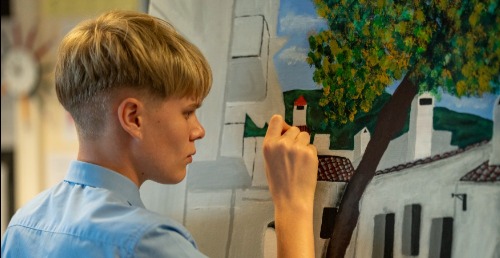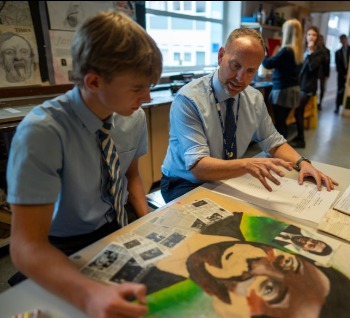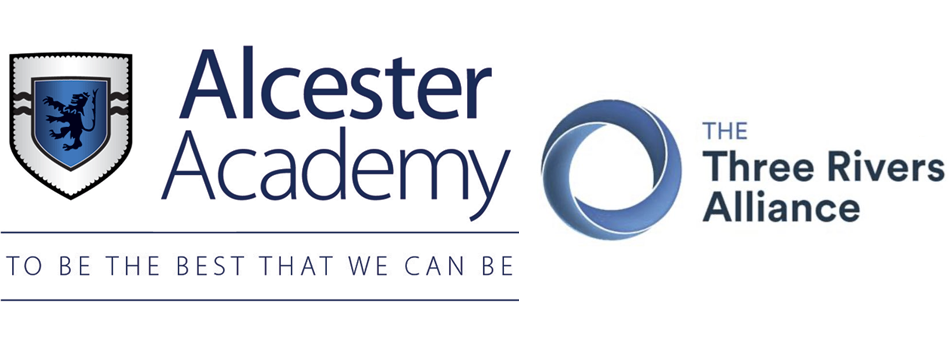Art & Design

Art & Design
jamesyarrington@alcesteracademy.org.uk
Miss O Nemeshanyi: Teacher of KS3 Art, KS4 Fine Art and KS4 Photography
OliviaNemeshanyi@alcesteracademy.org.uk
LaurenPass@alcesteracademy.org.uk

Key Stage 3
Curriculum Intent
As two closely-linked subject areas, through art and photography, our primary aim is to build confidence, resilience and to foster a love of learning, experimentation and hard work. Students arrive in year 7 very unsure of their abilities and we decide to return to basics with drawing, building skills and an awareness of visual presentation. Very quickly, staff are able to identify a range of needs and challenge the more able, at the same time building resilience with those whose confidence threatens to hamper development.
Learners soon realise that they are able to make progress effectively through the personalised programme that we offer. Gradually, technical skills using a range of media evolve allowing students to experiment with scale and photographic supporting materials in particular.
Throughout key stage 3, all learners are encouraged to investigate literacy elements within the subject areas, researching the work of other artists and becoming aware of their style characteristics, their intentions and the context of the work, both at the time of its creation and also within present-day society. Students also use written and verbal feedback to drive their own and each other’s development through staff and peer assessment. Student responses are prompted through a planned questioning focus during lessons, both on the whiteboard, through verbal interaction and also within PTR sheets in sketchbooks.
All of these features effectively build the skills required for study at key stage 4. The expectation of the department dictates that commitment outside lessons is essential for success; something that we believe prepares all learners for the demands of the new GCSE courses. We also cover the various career possibilities in art and design and photography through display material in the department but also via the newly-established photography course.
Curriculum Implementation (see also Long Term Plans)
Throughout KS3, students learn the skills and ways in which to gain and continue building knowledge within the subject. In addition to technical challenges, learners are always encouraged to consider their intentions when using a particular media. They would be expected to be able to justify the selection of materials for the purpose of the piece. Students’ knowledge of artsists’ work extends from the characteristics of his her style to reasons for links to the project ad also that artist’s intentions, what he or she was trying to portray, the intended audience.
At key stage 3, we encourage learners to reflect on themselves as people and also those around them. Both the year 7 ‘Pop Art’ and year 8 ‘Cubism’ units of work involve a clear focus upon self- identity and students are able to investigate things that are personal to them e.g. family, friends, pets, hobbies, favourite celebrities/sports stars etc. This echoes starting points of many artists, both within the themes studied but also as they progress to the more flexible and broad-based GCSE approach in year 9 and onwards, even involving possible responses to the GCSE exam starting points in year 11.
Much of the work at the beginning of projects is modelled by staff to build confidence and also establish expectations. The department also utilises exemplar work from past and present students and encourages peer coaching to share good practice and drive success.
Projects studied at KS3
Year 7 - Drawing, Colour, Natural forms, Pop Art
Year 8 – Surrealism and Cubism
Progress is assessed at a variety of stages and the timings of these are always planned to evidence optimum impact within a student’s work. AfL is personalised and takes on the form of both verbal and written feedback by both staff and peers. Students’ responses drive next steps and staff revisit these to extend the dialogue if appropriate. Data is collected to support reporting windows and use of ATLs closely reflect homework performance, as recorded in the front of sketchbooks.
Curriculum Impact
A significant number of students choose to purse an art subject at KS4.The resilience adopted through years 7 and 8 effectively prepare learners for the challenge ahead. The personalised approach and focus from prior projects allow students to then become more flexible when understanding and appreciating works of other artists and their intentions when creating pieces.
Those not opting for art or photography at GCSE level are given the chance to experiment with media and processes during years 7 and 8, building confidence and presentational skills required for other curriculum areas. They have developed knowledge of themselves and their peers as individuals and have learned how to justify their choices and ideas.
Key Stage 4
GCSE Fine Art
GCSE Photography
Curriculum Intent
In year 9, students begin to study the GCSE course through a more fostered approach; many of the earliest tasks being introduced as a step by step format, allowing learners to develop ideas and build resilience with greater guidance.
As the course evolves, students are encouraged to take risks, personalise their pathways and justify these choices. As a department, we are constantly seeking ways in which to challenge progress to exceed prior targets. This may take the form of extending the scale of work or increasing the sophistication of written elements of the portfolio, for example when linking work to that of other artists, students are expected to highlight reasons for their selections and the intention of the artist. We are insistent that this is a development of skills and knowledge from KS3 and not to be seen as a new approach. We believe that the journey as an artist should not abandon knowledge from previous learning, but link to prior experience.
The level of chosen subject matter within these personalised project developments or pathways, we believe, prepares students for the subject at the next level. The department has strong links with local post-16 providers and maintains an awareness of KS5 demands and expectations. For example, when working towards the exam in art, students are asked to look at their chosen starting point through a social lens and if at all possible introduce a topical focus to their project and resulting final outcome. This encourages them to read more widely on the subject, looking at news articles and link issues to the works of other like-minded artists.
Curriculum Implementation (see also Long Term Plans)
An overview (brief) of the topics covered and reference to teaching/learning styles i.e group work, independent study
How is it assessed (brief) and how does data collected support individuals future learning?
Year 9
Conflict – This project encourages students to look more closely at war, focusing upon not just military elements but also the impact of conflict on society. They are able to investigate how conflict re-models life and also explore war-based art, including the intention of the artist. Links to prior learning at KS3 from other subject areas can be revisited and staff are eager to discuss and gauge students’ understanding. For example the rise of the Nazi party and the Holocaust, as studied in year 8 History and how these events linked, were portrayed through Nazi propaganda and also from the Holocaust survivors’ view.
Years 10 and 11
The City – This particular part of the GCSE course flows smoothly from the investigations in year 9. Knowledge and appreciation of conflict and the city allows students to then move towards the city and society as a whole. They are encouraged to investigate issues which will demand greater depth to their current standing and prompt wider reading. Issues such as religion, politics, and the environment can be linked to prior conflict-based knowledge and enable some effective connections to artists using a variety of forums. The project develops and evolves over time and students’ focus points build towards final outcomes at a variety of stages. Photography students follow the same starting points and this allows for cross-subject links and materials, involving a team ethos amongst departmental staff.
Curriculum Impact
GCSE Results
Exam results at GCSE have, for a number of years, been incredibly positive. Positive SPI from last years’ leavers was 72.4% (0.75) and the residual was 0.73 in a school whose P8 score was O.77.
As a result of teaching across both key stages in art, a significant number of students pursue the subject at post-16.
Long Term Plans & Assessment Plan
Art LTP Year 7
Art LTP Year 8
Art LTP Year 9
Art LTP Year 10
Art LTP Year 11
Photography LTP Year 9
Photography LTP Year 10
Photography LTP Year 11
Examples of the kinds of assessments to expect: Art Assessment Plan
Examples of the kinds of assessments to expect: Photography Assessment Plan







